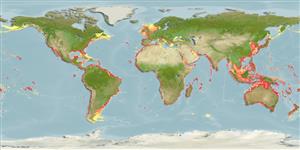Common names from other countries
Issue
Genetic data indicate that Mugil cephalus is globally a complex of species, At least 14 species (incl. former synonyms) have been recognized. The name should be applied only in North-East Atlantic and Mediterranean, Where species are sympatric, genetic and ecological data have confirmed the species validity (Refs. 89471,123406; 123405).
Environment: milieu / climate zone / depth range / distribution range
生態學
海洋; 淡水; 半鹹淡水 底中水層性; 降海洄游 (Ref. 51243); 深度上下限 0 - 120 m (Ref. 9321), usually 0 - 10 m. 8°C - 24°C (Ref. 4944); 62°N - 57°S, 180°W - 180°E (Ref. 117425)
Cosmopolitan in coastal waters of the tropical, subtropical and temperate zones of all seas. Eastern Pacific: California, USA to Chile (Ref. 2850). Western Pacific: Japan to Australia (Ref. 9812). Western Indian Ocean: from India to South Africa (Ref. 4393). Western Atlantic: Nova Scotia, Canada to Brazil (Ref. 7251); Cape Cod to southern Gulf of Mexico (Ref. 26938); absent in the Bahamas and most of West Indies and Caribbean (Ref. 7251, 9761). Eastern Atlantic: Bay of Biscay to South Africa, including the Mediterranean Sea and Black Sea (Ref. 7399). Reported in Sea of Okhotsk (Ref. 50550).
Length at first maturity / 大小 / 重量 / 年齡
Maturity: Lm 35.4, range 30 - ? cm
Max length : 100.0 cm SL 雄魚/尚未辨別雌雄; (Ref. 2804); common length : 50.0 cm SL 雄魚/尚未辨別雌雄; (Ref. 7399); 最大年齡: 16 年 (Ref. 28725)
背棘 (總數) : 5; 背的軟條 (總數) : 7 - 9; 臀棘: 3; 臀鰭軟條: 8 - 9. Diagnosis: body stout, cylindrical in cross-section, slightly compressed; head broad and flattened (Ref. 57400). Well developed adipose eyelid (Ref. 40476, 57400) covering most of pupil (Ref. 57400). Upper lip thin and without papillae (Ref. 57400), with 1-2 outer rows of small, moderately close-set, unicuspid teeth and up to 6 inner rows of smaller, bicuspid teeth (Ref. 81659). Lower lip with outer row of small unicuspid teeth and sometimes 1 or more inner rows of smaller, bicuspid teeth (Ref. 81659). Hind end of upper jaw reaching a vertical line from anterior eye margin; maxillary pad not visible below corner of mouth when closed; origin of 1st dorsal fin nearer to snout tip than to caudal-fin base (Ref. 57400). Anterior parts and bases of 2nd dorsal and anal fins with a moderately dense coverage of scales (Ref. 57400, 81659). Pectoral axillary process (Ref. 57400). 13-15 scale rows between origins of dorsal and pelvic fins (Ref. 57400, 81659). Pelvic fins, anal fin, and lower lobe of caudal fin yellowish in specimens from the tropical Atlantic coast of Africa (Ref. 57400, 81659).
Adults are found in coastal waters (Ref. 2850, 44894, 57400), often entering estuaries and rivers (Ref. 2847, 3573, 11230, 44894, 57400), sometimes far-up-river, lagoons and hypersaline environments (Ref. 57400). They are usually in schools over sand or mud bottom (Ref. 2850), between 0 and 10 m, occurring equally in tropical, subtropical and temperate waters (Project MUGIL). They are mainly diurnal, feeding on detritus, micro-algae and benthic organisms (Ref. 56548, 74902, 74760). Juveniles feed on zooplankton until about 3.0 cm SL (Ref. 59043). Reproduction takes place at sea, at various times of the year depending on the location (Ref. 74907, Amour). Adults form schools and migrate offshore to spawn and developing larvae migrate back inshore (Ref. 81659). There is absence of an obligatory freshwater phase in the life cycle (Ref. 74752). Females spawn 0.8 to 2.6 million eggs which develop at sea (Ref. 74912, Chen & Su 1986). Sexually mature at 3 to 4 years (Ref. 74902). Maximum length reported as 120 cm SL (Ref. 7399, 57400, 81659) remains to be confirmed (Project MUGIL). Maximum weight reported as 12 kg (Ref. 56527) seems too high for the area and remains to be confirmed (Project MUGIL). Widely cultivated in freshwater and brackish ponds (Ref. 2847, Jackson 1984, Liao 1981). Marketed fresh, dried, salted, and frozen; roe sold fresh or smoked (Ref. 9321); also used in Chinese medicine (Ref. 12166).
One spawning aggregation was observed in detail. This consisted of five fish, a female and four males. Males would press against the female, which took place as the entire group moved along slowly, facing into a fairly strong tidal flow.
Harrison, I.J., 1995. Mugilidae. Lisas. p. 1293-1298. In W. Fischer, F. Krupp, W. Schneider, C. Sommer, K.E. Carpenter and V. Niem (eds.) Guia FAO para Identification de Especies para lo Fines de la Pesca. Pacifico Centro-Oriental. 3 Vols. FAO, Rome. (Ref. 9321)
IUCN 瀕危狀態 (Ref. 130435)
Can't connect to MySQL database (fbapp). Errorcode: Too many connections
